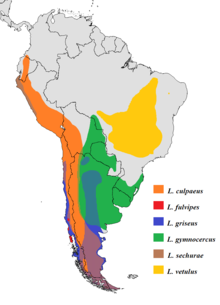| Lycalopex[1] | |
|---|---|

| |
| Scientific classification | |
| Domain: | Eukaryota |
| Kingdom: | Animalia |
| Phylum: | Chordata |
| Class: | Mammalia |
| Order: | Carnivora |
| Family: | Canidae |
| Tribe: | Canini |
| Subtribe: | Cerdocyonina |
| Genus: | Lycalopex Burmeister 1854 |
| Type species | |
| Canis magellanicus[3] | |
| Species | |

| |
| Range of the six living zorro species | |
| Synonyms | |
| |
The South American foxes (Lycalopex), commonly called raposa in Portuguese, or zorro in Spanish, are a genus from South America of the subfamily Caninae. Despite their name, they are not true foxes, but are a unique canid genus more closely related to wolves and jackals than to true foxes; some of them resemble foxes due to convergent evolution. The South American gray fox, Lycalopex griseus, is the most common species, and is known for its large ears and a highly marketable, russet-fringed pelt.
The second-oldest known fossils belonging to the genus were discovered in Chile, and date from 2.0 to 2.5 million years ago, in the mid- to late Pliocene.[4] The Vorohué Formation of Argentina has provided older fossils, dating to the Uquian to Ensenadan (Late Pliocene).[5]
- ^ Wozencraft, W. C. (2005). "Order Carnivora". In Wilson, D. E.; Reeder, D. M. (eds.). Mammal Species of the World: A Taxonomic and Geographic Reference (3rd ed.). Johns Hopkins University Press. ISBN 978-0-8018-8221-0. OCLC 62265494.
- ^ Cite error: The named reference
FWaustraliswas invoked but never defined (see the help page). - ^ Wilson, D. E.; Reeder, D. M., eds. (2005). Mammal Species of the World: A Taxonomic and Geographic Reference (3rd ed.). Johns Hopkins University Press. ISBN 978-0-8018-8221-0. OCLC 62265494.
- ^ Lucherini, M. & Luengos Vidal, E. M. (2008). "Lycalopex gymnocercus (Carnivora: Canidae)". Mammalian Species. 820: Number 820, pp. 1–9. doi:10.1644/820.1. hdl:11336/115900.
- ^ Vorohuen (sic; Vorohué) Formation at Fossilworks.org